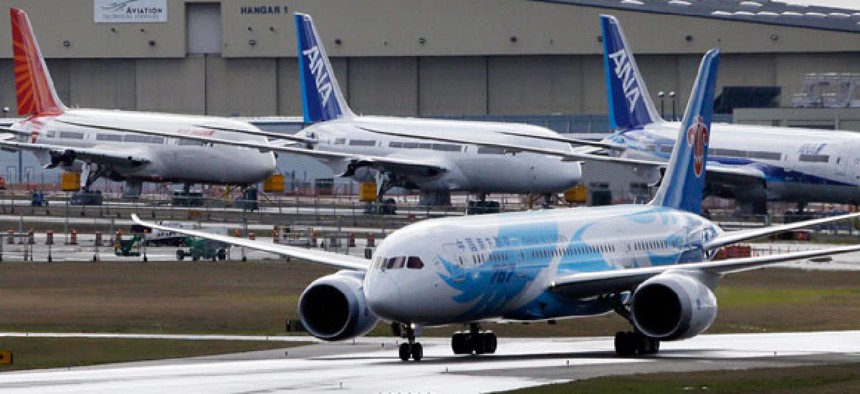FAA Did Not Require Boeing to Use Strict Test Standards on 787 Batteries

Elaine Thompson/AP
National Traffic Safety Board hearings explore certification process.
The Federal Aviation Administration decided not to impose strict test requirements for the lithium ion batteries used on Boeing’s 787 Dreamliner aircraft due to timing and the fact that they exceeded regulatory requirements, agency officials said at a National Transportation Safety Board hearing Tuesday.
The 787 fleet was grounded after battery fires occurred on aircraft in Japan and Boston in January. But last Friday, FAA said it expects to issue a directive this week that would allow the 787 to return to service after Boeing modifies the battery system.
NTSB hearings today and Wednesday focus on the battery fire on a Japan Airlines 787 at Logan International Airport in Boston on Jan 7. Chairwoman Debbie Hersman said, “The NTSB is holding this hearing to explore the battery's original design and certification. We are here to understand why the 787 experienced unexpected battery failures following a design program led by one of the world's leading manufacturers and a certification process that is well-respected throughout the international aviation community.”
The FAA approved the use of lithium ion batteries for the 787 on Oct. 11, 2007, based on special conditions governing flammability, charging and discharging and venting of gases from a fire overboard.
Mike Sinnett, Boeing vice president and chief project engineer for the 787, told the NTSB that the battery design assumed there would not be a catastrophic failure in 10 million hours of flight. Steve Boyd, manager of FAA’s airplane and flight crew interface branch, told board members that the agency approved the batteries because officials deemed it “extremely improbable” that the 787 would experience a battery fire “in the life of the fleet.”
Boyd said the special conditions imposed on the batteries did not take into account the kind of “thermal runaway” that occurred on the JAL 787 parked at Logan in January.
NTSB board member Robert Sumwalt had a hard time understanding the assumptions FAA and Boeing made about the safety of the batteries, asking if they expected two incidents after only 52,000 hours of flight time. Sinnett said the two incidents do not “automatically change our assumptions” saying Boeing was still trying to determine if it was an overall design error or “build error” with the specific batteries.
RTCA, a Washington non-profit that develops standards for the aviation industry (formerly known as the Radio Technical Commission for Aeronautics), came up with a new, more stringent set of standards in early 2008 for the use of lithium ion batteries on aircraft. Those include catastrophic testing to ensure that the batteries would not catch fire or explode in billions of hours of flight.
Boyd said the RTCA standard was “never a regulatory requirement” and it established conditions beyond FAA’s regulatory standards for the special conditions. He added that the agency saw no need to test catastrophic conditions with 787 batteries since the agreement with Boeing assumed such conditions would not occur.
Dorenda Baker, director of FAA’s aircraft certification service, said the agency did not require Boeing to use the RTCA standards due to timing, because it had already started work on the 787 and systems installed on the aircraft would help mitigate battery failures.
Boeing spokeman Marc Birtel told Nextgov that the company has adhered to the RTCA test standards in the modified 787 batteries it plans to install in the aircraft. “The latest set of testing took into account the testing guidelines provided by the RTCA, which were not available at the time we established our test plan earlier,” Birtel said.
John Goglia, a former NTSB board member and now an aviation safety consultant, said the FAA should have required Boeing to use the strict RTCA standards. He said Boeing and the FAA need to conduct risk analysis based on rigrorous tests.






